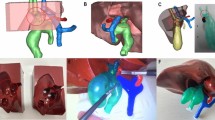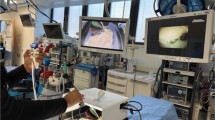Abstract
Background
There are few studies on simulation training in laparoscopic bilioenteric anastomosis. There is also a lack of mature and reliable training models for bilioenteric anastomosis. In this study, we aimed to assess a feasible training model for bilioenteric anastomosis. Surgeons can improve their surgical ability by performing laparoscopic bilioenteric anastomosis on this model through repeated training.
Method
The original articles related to simulation training in surgical anastomosis were identified from January 2000 to November 2021 in the Clarivate Analytics Web of Science Core Collection database. We conducted a bibliometric analysis based on the country of these publications and the type of anastomosis. A 3D-printed bilioenteric anastomosis model was applied in this study. Baseline data of 15 surgeons (5 surgeons of Attendings, 5 surgeons of Fellows, and 5 surgeons of Residents) were collected. The bilioenteric anastomosis data, including the operation time and operation score, were recorded and analyzed. A study of the learning curve was also performed for further assessment.
Result
Surgeons at different levels of experience exhibited different levels of performance in conducting laparoscopic bilioenteric anastomosis on this model. Experienced surgeons completed their first training session in a shorter time and obtained a higher surgical score. In turn, repeated training significantly shortened the time of laparoscopic bilioenteric anastomosis for each trainer and improved the surgical score. Surgeons with different levels of experience needed different numbers of cases to reach the stable period of the learning curve. Experienced surgeons were able to reach a proficient level through fewer training cases.
Conclusion
A suitable biliary-enteric anastomosis model can help surgeons conduct simulation training and provide experience and skill accumulation for future real operations. Our training model performed well in this study and can effectively accomplish this goal.




Similar content being viewed by others
References
Nealon WH, Urrutia F (1996) Long-term follow-up after bilioenteric anastomosis for benign bile duct stricture. Ann Surg 223(6):639–645
Shimi S, Banting S, Cuschieri A (1992) Laparoscopy in the management of pancreatic cancer: endoscopic cholecystojejunostomy for advanced disease. Br J Surg 79(4):317–319
Guerra F, Coletta D, Gavioli M, Coco D, Patriti A (2020) Minimally invasive surgery for the management of major bile duct injury due to cholecystectomy. J Hepatobiliary Pancreat Sci 27(4):157–163
Csendes A, Diaz JC, Burdiles P, Maluenda F, Nava O (1989) Mirizzi syndrome and cholecystobiliary fistula: a unifying classification. Br J Surg 76(11):1139–1143
Kapoor VK, Pradeep R, Haribhakti SP, Singh V, Sikora SS, Saxena R, Kaushik SP (1996) Intrahepatic segment III cholangiojejunostomy in advanced carcinoma of the gallbladder. Br J Surg 83(12):1709–1711
Waddell WR, Burbank CB (1952) Cholangiojejunostomy (Longmire operation) for relief of biliary obstruction due to carcinoma. N Engl J Med 247(24):929–932
van der Veen A, Brenkman HJF, Seesing MFJ, Haverkamp L, Luyer MDP, Nieuwenhuijzen GAP, Stoot J, Tegels JJW, Wijnhoven BPL, Lagarde SM et al (2021) Laparoscopic versus open gastrectomy for gastric cancer (LOGICA): a multicenter randomized clinical trial. J Clin Oncol 39(9):978–989
Ho KM, Cheng KC, Chan FK, Yeung YP (2021) Laparoscopic hepatectomy versus open hepatectomy for hepatocellular carcinoma: a propensity case-matched analysis of the long-term survival. Ann Hepatobiliary Pancreat Surg 25(1):1–7
de Rooij T, Klompmaker S, Abu Hilal M, Kendrick ML, Busch OR, Besselink MG (2016) Laparoscopic pancreatic surgery for benign and malignant disease. Nat Rev Gastroenterol Hepatol 13(4):227–238
Javed A, Shashikiran BD, Aravinda PS, Agarwal AK (2021) Laparoscopic versus open surgery for the management of post-cholecystectomy benign biliary strictures. Surg Endosc 35(3):1254–1263
Mazzone E, Puliatti S, Amato M, Bunting B, Rocco B, Montorsi F, Mottrie A, Gallagher AG (2021) A systematic review and meta-analysis on the impact of proficiency-based progression simulation training on performance outcomes. Ann Surg 274(2):281–289
El Khamali R, Mouaci A, Valera S, Cano-Chervel M, Pinglis C, Sanz C, Allal A, Attard V, Malardier J, Delfino M et al (2018) Effects of a multimodal program including simulation on job strain among nurses working in intensive care units: a randomized clinical trial. JAMA 320(12):1988–1997
Tolsgaard MG, Ringsted C, Rosthoj S, Norgaard L, Moller L, Freiesleben NC, Dyre L, Tabor A (2017) The effects of simulation-based transvaginal ultrasound training on quality and efficiency of care: a multicenter single-blind randomized trial. Ann Surg 265(3):630–637
Gupta DK, Khandker N, Stacy K, Tatsuoka CM, Preston DC (2017) Utility of combining a simulation-based method with a lecture-based method for fundoscopy training in neurology residency. JAMA Neurol 74(10):1223–1227
Aydin A, Raison N, Khan MS, Dasgupta P, Ahmed K (2016) Simulation-based training and assessment in urological surgery. Nat Rev Urol 13(9):503–519
Aydin A, Ahmed K, Abe T, Raison N, Van Hemelrijck M, Garmo H, Ahmed HU, Mukhtar F, Al-Jabir A, Brunckhorst O et al (2021) Effect of simulation-based training on surgical proficiency and patient outcomes: a randomised controlled clinical and educational trial. Eur Urol. https://doi.org/10.1016/j.eururo.2021.10.030
Ritter EM, Park YS, Durning SJ, Tekian AS (2021) The impact of simulation based training on the fundamentals of endoscopic surgery performance examination. Ann Surg. https://doi.org/10.1097/SLA.0000000000005088
Hohmann E, Brand JC, Rossi MJ, Lubowitz JH (2019) Proficiency-based training using simulator-based tools could be validated for certification of surgical procedural proficiency. Arthroscopy 35(12):3167–3170
Wei F, Wang W, Gong H, Cao J, Chen J, Chen H, Wang Z (2021) Reusable modular 3D-printed dry lab training models to simulate minimally invasive choledochojejunostomy. J Gastrointest Surg 25(7):1899–1901
Fann JI, Caffarelli AD, Georgette G, Howard SK, Gaba DM, Youngblood P, Mitchell RS, Burdon TA (2008) Improvement in coronary anastomosis with cardiac surgery simulation. J Thorac Cardiovasc Surg 136(6):1486–1491
Araujo SE, Delaney CP, Seid VE, Imperiale AR, Bertoncini AB, Nahas SC, Cecconello I (2014) Short-duration virtual reality simulation training positively impacts performance during laparoscopic colectomy in animal model: results of a single-blinded randomized trial : VR warm-up for laparoscopic colectomy. Surg Endosc 28(9):2547–2554
Naples R, French JC, Han AY, Lipman JM, Awad MM (2021) The impact of simulation training on operative performance in general surgery: lessons learned from a prospective randomized trial. J Surg Res 270:513–521
Seagull FJ, Rooney DM (2014) Filling a void: developing a standard subjective assessment tool for surgical simulation through focused review of current practices. Surgery 156(3):718–722
Hardon SF, van Gastel LA, Horeman T, Daams F (2021) Assessment of technical skills based on learning curve analyses in laparoscopic surgery training. Surgery 170(3):831–840
Hess CN, Peterson ED, Neely ML, Dai D, Hillegass WB, Krucoff MW, Kutcher MA, Messenger JC, Pancholy S, Piana RN et al (2014) The learning curve for transradial percutaneous coronary intervention among operators in the United States: a study from the National Cardiovascular Data Registry. Circulation 129(14):2277–2286
Vickers AJ, Savage CJ, Hruza M, Tuerk I, Koenig P, Martinez-Pineiro L, Janetschek G, Guillonneau B (2009) The surgical learning curve for laparoscopic radical prostatectomy: a retrospective cohort study. Lancet Oncol 10(5):475–480
Acknowledgements
The authors thank all the surgeons who participated in the current trial. The authors also appreciate all the colleagues at Sir Run-Run Shaw Hospital who contributed to this research.
Funding
This article is supported by the Education Reform Project of Zhejiang University School of Medicine (jgyb20202027).
Author information
Authors and Affiliations
Corresponding authors
Ethics declarations
Disclosures
Drs. Jiliang Shen, Mingyu Chen, Renan Jin, Zhifei Wang, and Jin Yang have no conflicts of interest or financial ties to disclose.
Additional information
Publisher's Note
Springer Nature remains neutral with regard to jurisdictional claims in published maps and institutional affiliations.
Supplementary Information
Below is the link to the electronic supplementary material.

464_2022_9465_MOESM1_ESM.jpg
Supplementary file1 (JPG 1331 KB)—(a) 3D model of the liver: the yellow tube is the bile duct, the red tube is the hepatic artery, the small green tube is the portal vein, and the big green tube is the inferior cava vein; (b) the pink intestinal 3D model; (c) preparation to perform bilioenteric anastomosis; (d) a hole was cut in the intestine to anastomose the bile duct; (e, f) the first suture entered laterally from the nine o’clock orientation of the bile duct into its lumen and came from the inside of the intestine to its outside; (g) three knots were tied on the outside of the bile duct and intestine; (h) the needle was sewn from the lateral side of the intestine back to the medial side for continuous suture of the posterior wall; (i) continuous suture of the posterior wall was performed from the nine o’clock orientation to the three o’clock orientation of the bile duct; (j) the needle was sewn from the medial side of the intestine back to the lateral side for continuous suture of the anterior wall; (k) continuous suture of the anterior wall was performed from the three o’clock orientation to the nine o’clock orientation of the bile duct; (l) three knots were tied on the position of the first knot

464_2022_9465_MOESM2_ESM.jpg
Supplementary file2 (JPG 1536 KB)—(a) Holistic view of a bilioenteric anastomosis completed on the model; (b) the main structure could be removed from the liver model; (c–f) the suture quality of each side, including the front, reverse, left and right sides, was evaluated by two surgical experts; (g) a 5-item Likert scale was used to evaluate the quality of each side, including five aspects: overall visual evaluation, suture margin, suture spacing, suture tearing, and suture leakage
Rights and permissions
About this article
Cite this article
Shen, J., Chen, M., Jin, R. et al. A study of simulation training in laparoscopic bilioenteric anastomosis on a 3D-printed dry lab model. Surg Endosc 37, 337–346 (2023). https://doi.org/10.1007/s00464-022-09465-7
Received:
Accepted:
Published:
Issue Date:
DOI: https://doi.org/10.1007/s00464-022-09465-7




